|
|
|
 |
| |
After switching between actors on the three previous
films, James Bond fans were introduced to Roger Moore
as the new 007 for the 1973 film "Live And Let
Die"...
|
|
Time Tunnel: The Roger Moore Era Begins
8th February 2007
After switching between actors on the three
previous films, James Bond fans were introduced to Roger
Moore as the new 007 for
the 1973 film "Live And Let
Die". It would be his first of seven
official outings as the legendary spy and secure his place in
history as the longest running Bond. On January 8th 1973, Time
Magazine reported from the production of the film and the
casting of Moore in the role:
A wristwatch
with a magnetic field to
deflect bullets. A bad guy named Tee
Hee who has a metal
hand that can crush a gun to talcum powder. Voodoo sacrifices
and a pool of 86 hungry crocodiles, each of them waiting
for just one bite of the struggling hero. It sounds like
a comic strip, and in a way it is. The newest James Bond
movie, Live and Let Die, is the most inventive—and
the most potentially lucrative—comic strip ever made,
two hours of thrilling, high-powered nonsense.
Filmed in Jamaica and New Orleans, with scenes yet to
be shot in Harlem, the movie takes Agent 007 to the fictional
island of San Monique, where Mr.
Big, the first black villain
in a Bond movie, runs a heroin-smuggling ring. There Bond—played
for the first time by Roger Moore, star of TV's The Saint —meets
a telepathic beauty named Solitaire (Jane Seymour), a black
double agent (Gloria Hendry) and the usual assortment of
outrageous villains, their seemingly indestructible henchmen
and an obstacle course of hazards that would have sent
even Superman running for his Valium. "There will
be more action packed into these two hours than any other
Bond film," brags Director Guy Hamilton. |
|
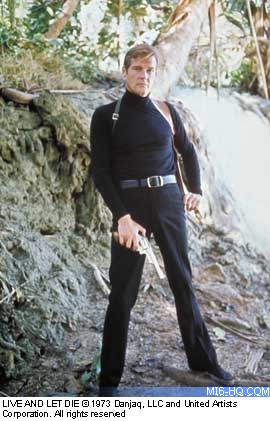 |
The producers, Harry Saltzman and Albert Broccoli, have already
grossed $200 million from the seven previous Bond movies: Dr.
No (1963), From Russia with
Love (1964), Goldfinger (1964), Thunderball (1965), You
Only Live Twice (1967), On
Her Majesty's Secret Service (1969) and Diamonds
Are Forever (1971). Investment in the latest:
$7,000,000. "We spend a lot of money," says Saltzman. "You
see it and you feel it. The physical size is there. It isn't
done with mirrors. I think a lot of the appeal of a Bond movie
is that you know that this is not done in a studio."
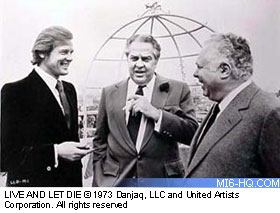
Above: Moore, Broccoli and Saltzman |
|
Feeding Time. For the crocodile scene,
for instance, Saltzman and Broccoli carved out a pond
on a crocodile and alligator farm in Jamaica. Since crocs
are sluggish once they are fed, 86 of the monsters, specially
selected for size and meanness, were starved for three
months, just so they could stay awake and snap their
jaws
with appropriate conviction.
How does Bond, who has been
placed by Mr. Big on a little island in the middle,
escape? He throws them some chicken heads, which were supposed
to attract the killers to himself, and while the crocodiles
are dining, walks across their backs to shore. Of course.
|
In another Jamaican scene, Bond commandeers a double-decker
bus and races away from Mr. Big's black thugs. A low-lying bridge
shears the top off the bus and it lands neatly atop the pursuing
car. Cost to prepare the bus, including two extra top decks,
and shoot the episode: $500,000. In one bizarre scene in New
Orleans, a Bond colleague stands watching a funeral. It is his
own, and as the coffin is carried up to him, he is stabbed by
Mr. Big's men. He falls, and the bottom of the coffin opens to
take him inside.
The Bond movie industry is the ultimate
consumer in the throwaway society. In a sensational speedboat
chase across Louisiana lakes and bayous—the boats
jump a highway in one scene—numerous cars, 17 speedboats
and eight planes were destroyed in the name of realism. "Our
violence is not personal violence," explains Saltzman. "We
commit mayhem on inanimate objects like boats, planes or
cars." He adds affably: "Of course people occasionally
get in between the hardware."
The producers see TV as their biggest
competitor. "We have to show the audience things that
they don't see on their box in the evening," says
Director Hamilton. "We tell them: 'Come with us for
a glorious ride. But leave your brains under the seat and
don't ask too many questions. Because if we have to stop
and explain things, we will lose momentum.' "
Not
only must the stunts be spectacular, but the locations
must be unusual or exotic. Indeed, locations are already
being scouted in Indonesia, Cambodia, Thailand and Singapore
for the next epic, The Man with the Golden Gun. |
|
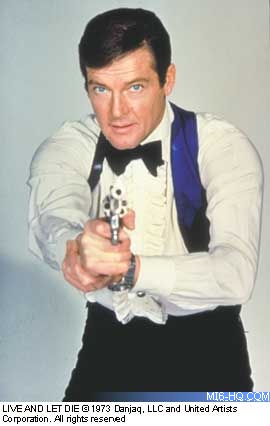 |
To ensure the all-important PG rating,
sex is sneaked in as comedy. "We suggest the erotic
with outrageous humor that disarms the censor," explains
Hamilton. "Bond can't make love on a bed—everyone
makes love on a bed —but on a waterbed filled with
fish. It is so ridiculous that it has a sort of charm of
its own. Besides, the children are more interested in the
fish in the bed than the adults on top of the bed."
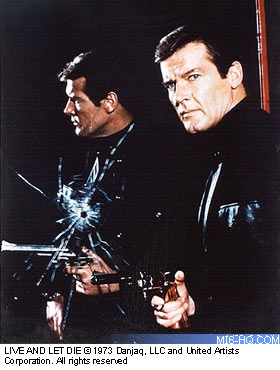 |
|
For most people, Sean
Connery, who played 007 in all
but one of the seven Bond features, is James Bond. (On
Her Majesty's Secret Service starred George
Lazenby.)
If he had not become tired of the role—and grown
rich playing it—Connery probably could have grown
old, gray and feeble in the part. But the smooth, handsome
Moore is, ironically, more like the original 007 in the
late Ian Fleming's novels than was Connery, a tough,
rugged Scot. "Fleming saw Bond as himself," observes
Saltzman, "as a kind of disenfranchised member of
the Establishment, Eton, Harrow and Cambridge. And Sean
was none of those.
Fleming would have been delighted
with Roger, however. He is the classic Englishman. He
looks good and he moves good." Hamilton is doing
nothing to cast Moore in the Connery mold. "The
fatal thing would be for Roger to step into Sean's shoes," he
says. "He must have his own way."
|
Boyish. While he is, at 44, two years older than Connery, Moore
appears much younger, with a boyish look that, for a man licensed
to kill, comes perilously close to being pretty. As the Saint
he was a trifle pudgy, and in his last TV series, The Persuaders,
his hair was much too long for Her Majesty's Secret Service.
To play the more athletic, squarer Bond, he lost 17 lbs. and
went to the barber three times before the makeup men were happy.
The son of a London policeman, Moore quit school when he was
15 to become an artist. Not succeeding at that, he enrolled in
the Royal Academy of Dramatic Arts. After a stint as an officer
in the British army, he was brought to Hollywood to play the
romantic hero in a number of dreary costume dramas. An unhappy
round of TV series followed in the '50s and '60s, and he eventually
went back to England, where he finally achieved stardom as the
Saint. Moore now lives in Denham, 20 miles outside London, where
he and his third wife Luisa have 17 acres, a swimming pool and
tennis courts.
Moore has spent much of his career taking
over parts other actors have made famous. He replaced James
Garner in the TV series Maverick and followed Movie Actors
George Sanders and Louis Hayward as the droll, urbane Saint.
"I
replace everyone," he jokes. "I'll be replacing
Mickey Mouse in about three years' time." He adds: "I
think the Bonds are marvelous subjects —escapist
entertainment expensively made. It's all going for you
as an actor. I often stop in the middle of a day's work
and say: 'Jesus Christ, they're really going to pay you
for being a kid and living out your fantasies!' " |
|
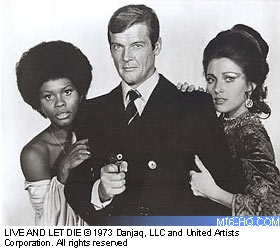 |
Related Articles
 James
Bond 101 Articles James
Bond 101 Articles
|
|
|